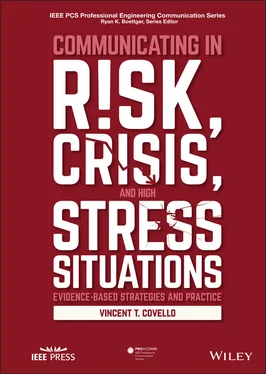19 Morality: People are often more concerned about activities or actions that are perceived to violate culturally based principles of morality and ethics (e.g., raising the price of a life‐saving prescription drug to a very high level) than about activities or actions that are perceived to be consistent with culturally based principles of morality and ethics (e.g., lying about the nationality or ethnicity of a child to protect the child from those who want to do harm because of child’s nationality or ethnicity).
20 Human vs. natural origin: People are often more concerned about activities and actions that are perceived to cause harm and are perceived to have their origin in human actions and failures (e.g., accidents, leaks, and spills at waste disposal or industrial sites caused by negligence, inadequate safeguards, inadequate supervision, or operator error) than about activities and actions that are perceived to cause harm and that are perceived to be caused by acts of nature or God (e.g., exposure to sunshine or cosmic rays).
Table 3.6 Risk perceptions (fear factors).
| Factor |
Conditions associated with higher perceived risks, increased concerns, greater fears |
Conditions associated with lower perceived risks, decreased concerns, and greater fears |
| Trust Voluntariness |
Lack of trust in responsible persons Involuntary/coerced/imposed |
Trust in responsible persons Voluntary/chosen |
| Scope/catastrophic potential |
High catastrophic potential |
Low catastrophic potential |
| Familiarity Understanding/visibility |
Unfamiliar/exotic Invisible/mechanisms or process not understood |
Familiar/routine Visible/mechanisms or process understood |
| Uncertainty |
Effects and outcomes unknown or uncertain |
Effects and outcomes known |
| Controllability (personal) |
Effects and outcomes uncontrollable by the person |
Effects and outcomes controllable by the person |
| Effects on children |
Children specifically at risk |
Children not specifically at risk |
| Effects manifestation |
Delayed effects |
Immediate effects |
| Effects on future generations |
Significant threat to future generations |
Little or no threat to future generations |
| Victim identity/specificity |
Identifiable and/or specific person or victims |
Nameless, faceless, or statistical victims |
| Pleasurable/dreaded |
Outcomes and effects not pleasurable/dreaded |
Outcomes and effects pleasurable/not dreaded |
| Awareness/media attention |
Much awareness/media attention |
Little awareness/media attention |
| Fairness/equity |
Inequitable distribution of risks and benefits |
Equitable distribution of risks and benefits |
| Benefits |
Unclear benefits |
Clear benefits |
| Reversibility Personal stake Nature of evidence Morality |
Effects and outcome irreversible Direct and significant perceived personal risk or threat Evidence from human studies Immoral/callous/unethical |
Effects and outcomes reversible Little or no perceived significant personal risk or threat Evidence from laboratory studies Moral/ethical |
| Origin |
Caused by human actions or failures |
Caused by acts of nature or God |
Risk perception theory states that risks are more worrisome, more fearful, and less acceptable if they are perceived as having the characteristics listed in Table 3.6and described above. Risk perception theory counters the conventional notion that “facts speak for themselves.” People commonly accept high risks but also become outraged over much less likely risks.
Risk perception factors can change concerns, perceptions of risk, fear, and perceived dangers exponentially. They explain the aversion of parts of the public toward activities and technologies such as nuclear power, required childhood vaccinations, and genetically modified food.
Perception factors also help to explain phenomena, such as the “not in my back yard” (NIMBY) and the “locally unwanted land use” (LULU) responses to many chemicals, nuclear, and other industrial facilities. For example, residents in communities where industrial facilities exist or are planned often become outraged if they believe government and industry officials:
1 have excluded them from meaningful participation in the decision‐making process;
2 have denied them the resources needed to evaluate or monitor health, safety, or environmental risks;
3 have denied them the opportunity to give their “informed consent” to management decisions that affect their lives or property;
4 have imposed or want to impose upon them facilities that provide few local economic benefits;
5 have imposed or want to impose upon them facilities that entail high costs to the community (e.g., adverse health, safety, wildlife, recreational, tourism, property value, traffic, noise, odor, scenic view, and quality of life effects);
6 have imposed or want to impose on them facilities that provide most of the benefits to those other than the community hosting the facility; and
7 have dismissed their opinions, fears, and concerns as irrational and irrelevant.
Critical to resolving NIMBY, LULU, and related risk‐related controversies is the recognition that a fairly distributed risk is more acceptable than an unfairly distributed one. A risk entailing significant benefits to the affected parties is more acceptable than a risk with no benefits. A risk where no alternatives exist is more acceptable than a risk an alternative technology could eliminate. A risk the affected have control over is more acceptable than a risk beyond their control. A risk that the parties at risk assess and decide voluntarily to accept is more acceptable than a risk that is imposed upon them.
Risk is multidimensional; size is only one of the relevant dimensions. If the validity of this point is accepted, then many risk communication strategies present themselves. Factors such as fairness, benefits, and voluntariness are often equal or more important to the public in judging the acceptability of a risk than the risk data provided by technical, engineering, and scientific professionals. Therefore, efforts to engage stakeholders and make a risk more fair, beneficial, or voluntary are as appropriate in making a risk more acceptable as efforts to make a risk technically smaller. Similarly, because control is important in determining the acceptability of a risk, efforts to engage people and share power, such as by establishing citizen or worker advisory committees or by supporting third‐party research, audits, inspections, and monitoring, are as appropriate in making a risk more acceptable as efforts to make a risk technically smaller.
In summary, deciding what level of risk ought to be acceptable is not a technical question but a social, cultural, and value question. People vary in how they assess risk acceptability. They weigh the various factors according to their own values, sense of risk, and perceived stake in the outcome. Because acceptability is a matter of values and opinions, and because values and opinions differ, debates about risk are often debates about values, accountability, and control.
3.5 Risk Communication Principles and Guidelines
Given increasing demands by stakeholders for timely, credible, accurate, and relevant information about risks and threats, the development of improved risk communications strategies and practical tools will continue to be the focus of increasing attention in years to come. The observations reported here and in later chapters are samples of the growing area of risk communication research and practice.
Читать дальше












